
Then and Now, Interdisciplinary Approaches in Yellowstone: Summer 2016 Special Exhibitions
The combined efforts of scientists, photographers, and artists have greatly impacted environmental conservation in the United States and, arguably, the world over.
Yellowstone National Park was established as the world’s first national park in 1872 following the famous expedition into the area led by scientist Ferdinand V. Hayden. This trip yielded documentation of Yellowstone’s geological and scenic treasures, the renowned photographs of William Henry Jackson, and the artwork of Thomas “Yellowstone” Moran. These artistic works, coupled with Hayden’s scientific findings, helped convince Congress and the American public of the importance of protecting our unique natural spaces.
In honor of the National Park Service’s centennial and in celebration of artists who’ve found inspiration in the Park, the Buffalo Bill Center of the West’s Whitney Western Art Museum has unveiled an exhibit titled “Inspiring Sights: Yellowstone through Artists’ Eyes” which remains open through 2017. Thomas Moran’s paintings and sketches can be found in this exhibit alongside the work of other historical artists like Albert Bierstadt, and contemporary artists who also chose this renowned park as their muse. Photographs made by William Henry Jackson on the 1871 Yellowstone expedition can be found in another special exhibit organized by the McCracken Research Library titled “Yellowstone Discovered: William Henry Jackson’s Lost Prints Reveal the Park for America,” on view in the John Bunker Sands Gallery through August 14, 2016.
A third special exhibition, “Invisible Boundaries: Exploring Yellowstone’s Great Animal Migrations,” heralds the collaborative efforts of wildlife biologist Arthur Middleton, photographer Joe Riis, artist James Prosek, and filmmaker Jenny Nichols. This contemporary team followed in the footsteps of Hayden, Jackson, and Moran in their interdisciplinary approach, but their goals differ from the members of the 1871 expedition whose main interest was cataloguing the geological and geothermal features of Yellowstone. Middleton, Riis, Prosek, and Nichols are most interested in calling our attention to a biological wonder of the park: its long-ranging wildlife. They hope to inspire exhibition visitors to consider how Yellowstone’s manmade boundaries affect migratory species, like elk, living in the park and the surrounding areas today.



Yellowstone has long been a global example for the challenges and opportunities associated with protecting our beloved natural spaces. The cooperative efforts of a scientist, a photographer, and an artist of the past helped us realize this. Now, another interdisciplinary team is igniting interest in protecting the diverse species who rely on these protected places and their borderlands. Visit the Center’s three special exhibitions to explore these stories further and learn more about the historical and continued importance of art in the Park.
Written By
Elenita Nicholas
Elenita Nicholas hails from the ever-cloudy San Francisco Bay Area but considers Cody, Wyoming her home-for-now as she interns in the Whitney Western Art Museum. She graduated from Georgetown University, with a bachelor’s degree in Anthropology, and will be entering a master’s program in Museum Anthropology at Columbia University where she hopes to specialize in digital media interpretation. As the Curatorial Intern this summer, she is focusing on digital media products - such as creating content for the audio guide, writing blog and social media posts, editing videos, and developing interpretive digital activities - for the Whitney Western.












